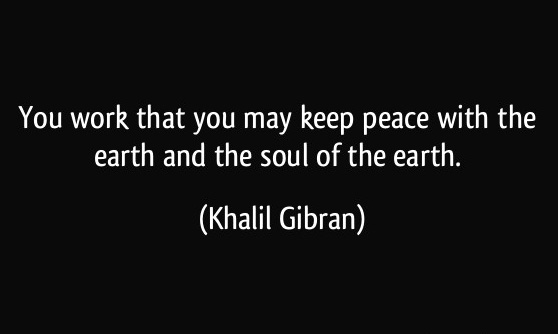The hallmarks of civilization are order and bureaucracy, the institutionalization of humanity into concrete rule-bound systems, balanced budgets, statistics, financial analysis, and the businesslike conversion of human beings into calculable units. The governing rationale of civilization is an obsession with the future, looking ahead and wanting to be bigger, stronger, better and indestructible. This is why civilization so often turns to “law and order” imposed by authoritarian strongmen. Despite the endurance of its narrative, all civilizations eventually collapse.
On the other hand, culture – soul – is by nature disorderly and unruly, relying on networks of family and personal relationships tied together largely through interdependent rituals and traditions. Soul spends more time looking back than ahead, going deeper rather than growing bigger, more focused on making meaning than making progress. Culture feeds on the detritus of civilization, and finds the creative potential in what is rejected, discarded and ignored; it feasts on ambiguity, metaphor and imagination. This is the soulful stuff of art, music, poetry and dance. When the grandiose plans and schemes of civilization collapse, cultures can still survive because the soul of culture resides in the human heart, especially the broken ones.
“More” is a civilized idea that’s become a fetish, nearly sexualized in its aspect. Our media is excited by seductive tales and images about billionaires, “the lifestyles of the rich and famous.” National identity is focused on the continuous growth of our Gross National Product, in other words, the creation of infinite wealth, even as it comes at the cost of life on this planet; it’s not just the world economy that’s heating up. To mask its nature, it sometimes calls itself “corporate culture” but civilization’s not a culture any more than its instruments of money or lifeless concrete are culture.
“Enough” is an idea that seeks to preserve, not exhaust soul, and values gratitude more than money; in this sense, it is anti-civilization. The games, the arts, the living things that endure all become the vital, life-affirming soul-stuff of culture. This is why we can speak of Native American culture or Black culture, or Latino culture, which despite civilization, have endured.
Civilization is not nostalgic and the bureaucratic mind always believes that what we know today is better than what we knew yesterday. To civilization, culture is an inconvenience to be overcome. In overcoming culture, civilization is ruthless and without mercy; it consumes culture then digests and regurgitates it as an imitation or cliché; when it cannot consume, it condemns, coerces, demolishes and destroys. When culture cannot satisfy civilization’s insatiable demands, civilization enslaves and commits genocide against people and nature, a Faustian deal with the devil proclaimed as progress.
Unique elements of tradition, land, architecture, creeks, trees, sense of place – what we call “culture” or soul – can exist for a while within the confines of civilization, its technology, economy, governance, and what’s generally regarded as its path of “progress.” Ironically, culture gives birth to civilization, but tragically, civilization kills culture’s soul. When possible, culture survives by going underground and living in the shadows. It employs a gray economy of sharing, barter and exchange. It thrives on trust, creativity and love. Unless it has been destroyed, as civilization unravels soul can re-emerge as a cohesive social force.
The soul of Sonoma? Let’s examine What It Is Not: noisy, overcrowded and in-a-hurry. Nor is it glitzy, snobby or stuck-up, phony, modernized, urban, polluted, or (at present) overbuilt. And What It Is? Down-to-earth, slower-paced, friendly, casual, locally-owned, civic-minded, generous, artsy, old-fashioned, authentic, respectful of nature and small-scale. It is old trees, young people and respected elders; its history is alive and present. Sonoma’s soul is the sound of water in the creeks, a cooling summer breeze, the smell of cow manure, children laughing in the Plaza, and public gatherings like farmers markets.
Developers call bigger buildings, more tourists, road improvements and piles of money signs of progress, but these products of civilization are soul killers; soul cannot be manufactured or imposed. Every General Plan of the past four decades has recognized the irreplaceable value of Sonoma culture precisely because Sonoma’s soul is vulnerable. During the past 30 years, I that soul has slowly weakened under the relentless monetary pressure of civilization. That pressure is particularly strong right now, and it will require brave and tireless hearts to save Sonoma’s soul.






Amen! Please, we need more articles that talk about this issue. The tourism board gets 2% of the TOT which it uses to promote more and more tourism which gets more money to promote more tourism. It is circular logic that benefits only the tourism board and wreaks havoc on our small town. Let’s develop other economic models besides ONLY tourism and tasting rooms.
How much money is Sonoma and the Visitors Center spending on promoting tourism to downtown Sonoma? Why is money being spent on more tourism when we need to replace the infrastructure? I’ve suggested many times to the planning commission and city council to fix the problems here before creating more before promoting tourism.
The Sonoma Tourism Improvement District was given a ten-year deal with the City of Sonoma, for which the TID collects about $750,000/yr. (at present occupancy rates); the Visitor’s Bureau has been granted $100,000/yr. for three years.